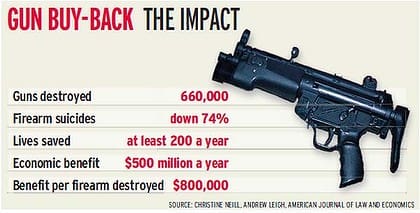Wow! According to a new study by former Australian Treasury economist Christine Neill, Australia’s assault weapons ban—I mean “buy back” has cut firearm suicides by 74 per cent, saving 200 lives a year. ”I fully expected to find no effect at all,” Neill told the smh.com.au. ”That we found such a big effect and that it meshed with a range of other data was just shocking, completely unexpected.” So . . . no pre-judgement or bias then. Nope. None at all . . .
Dr Neill says that while it seems surprising that a 20 per cent cut in the number of firearms would have cut the number of suicides from firearms by 74 per cent, none of her academic colleagues have found fault with her finding.
Look OK to you? Looks OK to me. The fact that her report’s co-author is a newly elected MP says nothing whatsoever about any underlying political agenda. Besides, the study is about to be published in the Oxford [UK] based The American Law and Economics Review, which says this about its standards:
The American Law and Economics Review is a refereed journal which maintains the highest scholarly standards and that is accessible to the full range of membership of the American Law and Economics Association, which includes practising lawyers, consultants, and academic lawyers and economists.
B-b-b-b-ut what about John Lott! Surely any study involving firearms statistics MUST be vetted by the man whose More Guns, Less Crime set the standards for death by stats. What would he make of this, then?
[The study’s authors] used what is known as a difference-in-differences approach, exploiting the fact that some states withdrew guns more quickly than others and examining whether their firearm suicide rates fell faster.
A previous study had found no nationwide effect, noting that firearm suicides began falling before the buyback. However, Dr Neill and Dr Leigh found that states such as Tasmania that withdrew guns quickly had a much bigger decline in firearm suicides than states such as NSW that withdrew more slowly. Whereas the earlier study had found an increase in suicides by other methods, suggesting substitution, Dr Neill’s study found no evidence of substitution within any state.
”It is simply not the case that there was an increase in non-firearm suicide deaths in states that brought back more firearms,” she said.
”I am confident these lives were saved.”
And I’m confident Lott would make minced meat out of this. Especially after seeing Neill and The Herald begin back-pedaling.
Most of Australia’s 2100 suicides each year do not involve firearms, making the 200 lives saved as a result of the firearm ban small in relation to the suicide total. But Dr Neill said applying an accepted financial value to each of these human lives resulted in an economic boost of $500 million a year – an outcome, she said, that represented $800,000 for each weapon destroyed.
Such a bargain! All you have to do to save money is ban guns! Who’d a thunk it.





Um, do people commit suicide with assault weapons? I would not think that would be the fire arm of choice, as opposed to a hand gun. I guess I'm wondering what the connection is between assault weapons and suicides.
Sorry, one more question. What does gun ownership, of any type weapon, have to do with depression, which is commonly the trigger for suicide?
Over the period 1979-98, the most frequent method used by men was firearms (27%), followed by hanging (26%) carbon monoxide (20%), and poisoning (12%). Between 1979 and 1998 men’s use of firearms as a method of suicide declined from 7.0 to 2.4 per 100,000 persons. Firearms was the leading cause of suicide death among men until 1989, when hanging became the leading cause.
Male deaths from hanging increased from 2.6 in 1979 to 11.2 per 100,000 persons in 1998, and for deaths from carbon monoxide poisoning the rate increased from 2.2 to 5 per 100,000 persons.
Source; Aust. Bureau of statistics, 4102.0 Aust. social trends 2000.
Owning a gun is not a reason or cause of suicide, it is a method and when access to one method is restricted the use of other methods increase. It is no differrent in Australia.
When a person believes that living has become a fate worse than death, the method by which they choose to commit the act of suicide is irrelevant. If fewer people have committed suicide then it is because less people killed themselves not because of rope, car or gun buybacks.
Comments are closed.